+ データを開く
データを開く
- 基本情報
基本情報
| 登録情報 | データベース: PDB / ID: 8ykd | ||||||
|---|---|---|---|---|---|---|---|
| タイトル | Cryo-EM structure of ADGRG2-Gs complex with NTF nanobody | ||||||
 要素 要素 |
| ||||||
 キーワード キーワード | MEMBRANE PROTEIN / GPCR | ||||||
| 機能・相同性 |  機能・相同性情報 機能・相同性情報Olfactory Signaling Pathway / Sensory perception of sweet, bitter, and umami (glutamate) taste / Synthesis, secretion, and inactivation of Glucagon-like Peptide-1 (GLP-1) / sensory perception of chemical stimulus / Activation of the phototransduction cascade / mu-type opioid receptor binding / corticotropin-releasing hormone receptor 1 binding / beta-2 adrenergic receptor binding / Activation of G protein gated Potassium channels / G-protein activation ...Olfactory Signaling Pathway / Sensory perception of sweet, bitter, and umami (glutamate) taste / Synthesis, secretion, and inactivation of Glucagon-like Peptide-1 (GLP-1) / sensory perception of chemical stimulus / Activation of the phototransduction cascade / mu-type opioid receptor binding / corticotropin-releasing hormone receptor 1 binding / beta-2 adrenergic receptor binding / Activation of G protein gated Potassium channels / G-protein activation / G beta:gamma signalling through PI3Kgamma / Prostacyclin signalling through prostacyclin receptor / G beta:gamma signalling through PLC beta / ADP signalling through P2Y purinoceptor 1 / Thromboxane signalling through TP receptor / Presynaptic function of Kainate receptors / G beta:gamma signalling through CDC42 / Inhibition of voltage gated Ca2+ channels via Gbeta/gamma subunits / G alpha (12/13) signalling events / Glucagon-type ligand receptors / G beta:gamma signalling through BTK / ADP signalling through P2Y purinoceptor 12 / Adrenaline,noradrenaline inhibits insulin secretion / Cooperation of PDCL (PhLP1) and TRiC/CCT in G-protein beta folding / Ca2+ pathway / Thrombin signalling through proteinase activated receptors (PARs) / G alpha (z) signalling events / Extra-nuclear estrogen signaling / G alpha (s) signalling events / G alpha (q) signalling events / G alpha (i) signalling events / Glucagon-like Peptide-1 (GLP1) regulates insulin secretion / High laminar flow shear stress activates signaling by PIEZO1 and PECAM1:CDH5:KDR in endothelial cells / Vasopressin regulates renal water homeostasis via Aquaporins / spermatid development / D1 dopamine receptor binding / adenylate cyclase-activating adrenergic receptor signaling pathway / insulin-like growth factor receptor binding / ionotropic glutamate receptor binding / adenylate cyclase activator activity / G protein-coupled receptor activity / G-protein beta/gamma-subunit complex binding / adenylate cyclase-activating G protein-coupled receptor signaling pathway / photoreceptor disc membrane / cellular response to catecholamine stimulus / adenylate cyclase-activating dopamine receptor signaling pathway / cellular response to prostaglandin E stimulus / G-protein beta-subunit binding / heterotrimeric G-protein complex / sensory perception of taste / signaling receptor complex adaptor activity / retina development in camera-type eye / GTPase binding / phospholipase C-activating G protein-coupled receptor signaling pathway / cell surface receptor signaling pathway / cell population proliferation / apical plasma membrane / G protein-coupled receptor signaling pathway / GTPase activity / synapse / GTP binding / protein-containing complex binding / metal ion binding / membrane / cytoplasm / cytosol 類似検索 - 分子機能 | ||||||
| 生物種 |  Spodoptera (蝶・蛾) Spodoptera (蝶・蛾) | ||||||
| 手法 | 電子顕微鏡法 / 単粒子再構成法 / クライオ電子顕微鏡法 / 解像度: 2.9 Å | ||||||
 データ登録者 データ登録者 | Huang, S.M. / Sheng-chao, G. | ||||||
| 資金援助 |  中国, 1件 中国, 1件
| ||||||
 引用 引用 |  ジャーナル: Nat Chem Biol / 年: 2025 ジャーナル: Nat Chem Biol / 年: 2025タイトル: Development of an allosteric adhesion GPCR nanobody with therapeutic potential. 著者: Yuan Zheng / Dan Jiang / Yan Lu / Chao Zhang / Shen-Ming Huang / Haocheng Lin / Daolai Zhang / Shengchao Guo / Jifei Han / Jun Chen / Yaxuan He / Mingxiang Zhang / Yanhui Gao / Yongyuan Guo / ...著者: Yuan Zheng / Dan Jiang / Yan Lu / Chao Zhang / Shen-Ming Huang / Haocheng Lin / Daolai Zhang / Shengchao Guo / Jifei Han / Jun Chen / Yaxuan He / Mingxiang Zhang / Yanhui Gao / Yongyuan Guo / Ran Wei / Ming Xia / Yingying Qin / Zhaoqian Liu / Fan Yang / Shaohua Ge / Fan Yi / Xiao Yu / Hui Lin / Peng Xiao / Jin-Peng Sun / Shiqing Feng /  要旨: Allosteric modulation of receptor responses to endogenous agonists has therapeutic value, maintaining ligand profiles, reducing side effects and restoring mutant responses. Adhesion G-protein-coupled ...Allosteric modulation of receptor responses to endogenous agonists has therapeutic value, maintaining ligand profiles, reducing side effects and restoring mutant responses. Adhesion G-protein-coupled receptors (aGPCRs), with large N termini, are ideal for allosteric modulator development. We designed a nanobody strategy targeting ADGRG2 N-terminal fragments and got a specific nanobody Nb23-bi, which promoted dehydroepiandrosterone (DHEA)-induced ADGRG2 activation and reversed mutant-induced dysfunctions. By combining structural characterization, crosslinking mass spectrometry, mutational analysis and molecular dynamics simulations, we clarified the allosteric mechanism of how the Nb23-bi modulates conformational changes in the DHEA-binding pocket. Animal studies showed that Nb23-bi promoted the response of DHEA in alleviating testicular inflammation and reversing mutant defects. In summary, we developed an allosteric nanobody of ADGRG2 and gained insights into its functions in reversing disease-associated dysfunctions. Our study may serve as a template for developing allosteric modulators of other aGPCRs for biological and therapeutic purposes. | ||||||
| 履歴 |
|
- 構造の表示
構造の表示
| 構造ビューア | 分子:  Molmil Molmil Jmol/JSmol Jmol/JSmol |
|---|
- ダウンロードとリンク
ダウンロードとリンク
- ダウンロード
ダウンロード
| PDBx/mmCIF形式 |  8ykd.cif.gz 8ykd.cif.gz | 275.5 KB | 表示 |  PDBx/mmCIF形式 PDBx/mmCIF形式 |
|---|---|---|---|---|
| PDB形式 |  pdb8ykd.ent.gz pdb8ykd.ent.gz | 195.8 KB | 表示 |  PDB形式 PDB形式 |
| PDBx/mmJSON形式 |  8ykd.json.gz 8ykd.json.gz | ツリー表示 |  PDBx/mmJSON形式 PDBx/mmJSON形式 | |
| その他 |  その他のダウンロード その他のダウンロード |
-検証レポート
| 文書・要旨 |  8ykd_validation.pdf.gz 8ykd_validation.pdf.gz | 1.2 MB | 表示 |  wwPDB検証レポート wwPDB検証レポート |
|---|---|---|---|---|
| 文書・詳細版 |  8ykd_full_validation.pdf.gz 8ykd_full_validation.pdf.gz | 1.2 MB | 表示 | |
| XML形式データ |  8ykd_validation.xml.gz 8ykd_validation.xml.gz | 41.6 KB | 表示 | |
| CIF形式データ |  8ykd_validation.cif.gz 8ykd_validation.cif.gz | 64.9 KB | 表示 | |
| アーカイブディレクトリ |  https://data.pdbj.org/pub/pdb/validation_reports/yk/8ykd https://data.pdbj.org/pub/pdb/validation_reports/yk/8ykd ftp://data.pdbj.org/pub/pdb/validation_reports/yk/8ykd ftp://data.pdbj.org/pub/pdb/validation_reports/yk/8ykd | HTTPS FTP |
-関連構造データ
| 関連構造データ |  39365MC M: このデータのモデリングに利用したマップデータ C: 同じ文献を引用 ( |
|---|---|
| 類似構造データ | 類似検索 - 機能・相同性  F&H 検索 F&H 検索 |
- リンク
リンク
- 集合体
集合体
| 登録構造単位 | 
|
|---|---|
| 1 |
|
- 要素
要素
-Guanine nucleotide-binding protein ... , 3種, 3分子 ABG
| #1: タンパク質 | 分子量: 41879.465 Da / 分子数: 1 / 変異: G236A,A259D,S262D,L272D,A366S,I372A,V375I / 由来タイプ: 組換発現 / 由来: (組換発現)  Spodoptera (蝶・蛾) Spodoptera (蝶・蛾)発現宿主:  Baculovirus expression vector pFastBac1-HM (ウイルス) Baculovirus expression vector pFastBac1-HM (ウイルス)参照: UniProt: P63091 |
|---|---|
| #2: タンパク質 | 分子量: 39418.086 Da / 分子数: 1 / 由来タイプ: 組換発現 / 由来: (組換発現)  Spodoptera (蝶・蛾) / 遺伝子: GNB1 Spodoptera (蝶・蛾) / 遺伝子: GNB1発現宿主:  Baculovirus expression vector pFastBac1-HM (ウイルス) Baculovirus expression vector pFastBac1-HM (ウイルス)参照: UniProt: P62871 |
| #3: タンパク質 | 分子量: 12104.898 Da / 分子数: 1 / 由来タイプ: 組換発現 / 由来: (組換発現)  Spodoptera (蝶・蛾) / 遺伝子: mRhiFer1_005810 Spodoptera (蝶・蛾) / 遺伝子: mRhiFer1_005810発現宿主:  Baculovirus expression vector pFastBac1-HM (ウイルス) Baculovirus expression vector pFastBac1-HM (ウイルス)参照: UniProt: A0A7J7XNR4 |
-抗体 , 2種, 2分子 NS
| #4: 抗体 | 分子量: 13885.439 Da / 分子数: 1 / 由来タイプ: 組換発現 / 由来: (組換発現)  Spodoptera (蝶・蛾) Spodoptera (蝶・蛾)発現宿主:  Baculovirus expression vector pFastBac1-HM (ウイルス) Baculovirus expression vector pFastBac1-HM (ウイルス) |
|---|---|
| #6: 抗体 | 分子量: 26640.643 Da / 分子数: 1 / 由来タイプ: 組換発現 / 由来: (組換発現)  Spodoptera (蝶・蛾) Spodoptera (蝶・蛾)発現宿主:  Baculovirus expression vector pFastBac1-HM (ウイルス) Baculovirus expression vector pFastBac1-HM (ウイルス) |
-タンパク質 / 非ポリマー , 2種, 2分子 R

| #5: タンパク質 | 分子量: 98934.797 Da / 分子数: 1 / 由来タイプ: 組換発現 / 由来: (組換発現)  Spodoptera (蝶・蛾) / 遺伝子: Adgrg2, Gpr64, Me6 Spodoptera (蝶・蛾) / 遺伝子: Adgrg2, Gpr64, Me6発現宿主:  Baculovirus expression vector pFastBac1-HM (ウイルス) Baculovirus expression vector pFastBac1-HM (ウイルス)参照: UniProt: Q8CJ12 |
|---|---|
| #7: 化合物 | ChemComp-AND / |
-詳細
| 研究の焦点であるリガンドがあるか | Y |
|---|---|
| Has protein modification | Y |
-実験情報
-実験
| 実験 | 手法: 電子顕微鏡法 |
|---|---|
| EM実験 | 試料の集合状態: PARTICLE / 3次元再構成法: 単粒子再構成法 |
- 試料調製
試料調製
| 構成要素 | 名称: Complex of ADGRG2 with nanonody and G protein trimer タイプ: COMPLEX / Entity ID: #1-#6 / 由来: RECOMBINANT | ||||||||||||||||||||
|---|---|---|---|---|---|---|---|---|---|---|---|---|---|---|---|---|---|---|---|---|---|
| 由来(天然) |
| ||||||||||||||||||||
| 由来(組換発現) | 生物種:  | ||||||||||||||||||||
| 緩衝液 | pH: 7.5 | ||||||||||||||||||||
| 試料 | 包埋: NO / シャドウイング: NO / 染色: NO / 凍結: YES | ||||||||||||||||||||
| 急速凍結 | 凍結剤: ETHANE |
- 電子顕微鏡撮影
電子顕微鏡撮影
| 実験機器 | 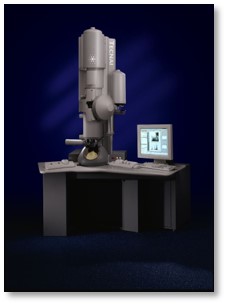 モデル: Tecnai F30 / 画像提供: FEI Company |
|---|---|
| 顕微鏡 | モデル: FEI TECNAI F30 |
| 電子銃 | 電子線源:  FIELD EMISSION GUN / 加速電圧: 300 kV / 照射モード: OTHER FIELD EMISSION GUN / 加速電圧: 300 kV / 照射モード: OTHER |
| 電子レンズ | モード: BRIGHT FIELD / 最大 デフォーカス(公称値): 2200 nm / 最小 デフォーカス(公称値): 1200 nm |
| 撮影 | 電子線照射量: 60 e/Å2 / フィルム・検出器のモデル: GATAN K3 (6k x 4k) |
- 解析
解析
| EMソフトウェア |
| ||||||||||||||||||||||||
|---|---|---|---|---|---|---|---|---|---|---|---|---|---|---|---|---|---|---|---|---|---|---|---|---|---|
| CTF補正 | タイプ: PHASE FLIPPING AND AMPLITUDE CORRECTION | ||||||||||||||||||||||||
| 3次元再構成 | 解像度: 2.9 Å / 解像度の算出法: FSC 0.143 CUT-OFF / 粒子像の数: 241188 / 対称性のタイプ: POINT | ||||||||||||||||||||||||
| 拘束条件 |
|
 ムービー
ムービー コントローラー
コントローラー



 PDBj
PDBj
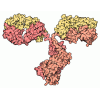
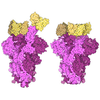
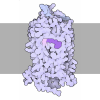


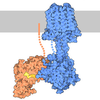






 Homo sapiens (ヒト)
Homo sapiens (ヒト)